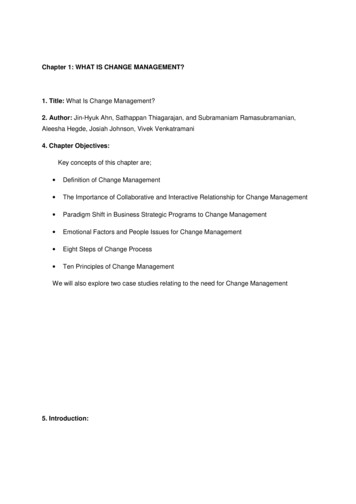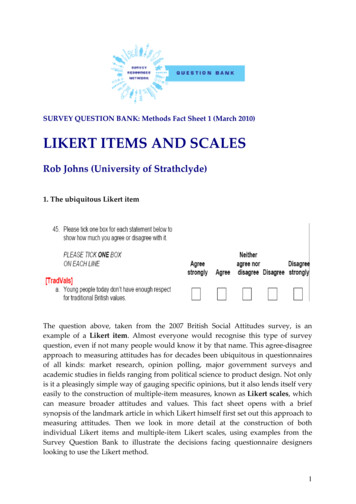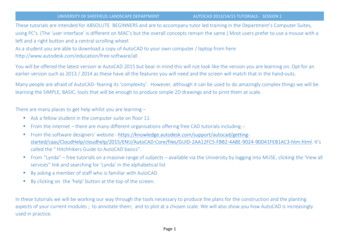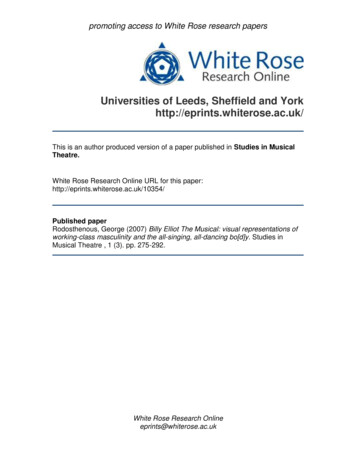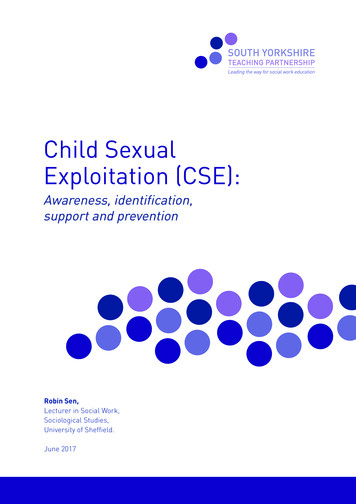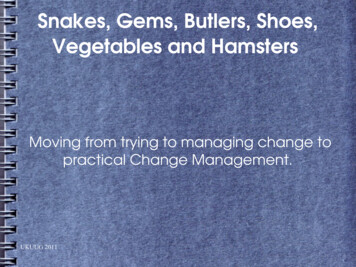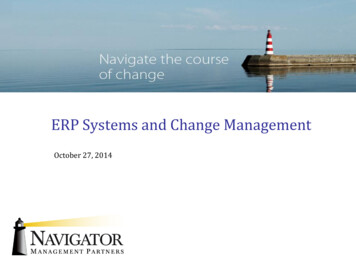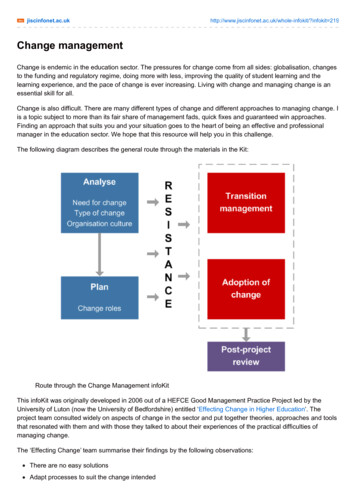
Transcription
e-infokit/?infokit 219Change managementChange is endemic in the education sector. The pressures for change come from all sides: globalisation, changesto the funding and regulatory regime, doing more with less, improving the quality of student learning and thelearning experience, and the pace of change is ever increasing. Living with change and managing change is anessential skill for all.Change is also difficult. There are many different types of change and different approaches to managing change. Itis a topic subject to more than its fair share of management fads, quick fixes and guaranteed win approaches.Finding an approach that suits you and your situation goes to the heart of being an effective and professionalmanager in the education sector. We hope that this resource will help you in this challenge.The following diagram describes the general route through the materials in the Kit:Route through the Change Management infoKitThis infoKit was originally developed in 2006 out of a HEFCE Good Management Practice Project led by theUniversity of Luton (now the University of Bedfordshire) entitled ‘Effecting Change in Higher Education’. Theproject team consulted widely on aspects of change in the sector and put together theories, approaches and toolsthat resonated with them and with those they talked to about their experiences of the practical difficulties ofmanaging change.The ‘Effecting Change’ team summarise their findings by the following observations:There are no easy solutionsAdapt processes to suit the change intended
Change requires teamwork and leadership (and the two are related)Work with the culture (even when you want to change it)Communicate, communicate, communicateIn the 2014 update we have amended the core model and associated resources with more evidence-basedresearch from projects involving large-scale change, focusing on: organisational efficiency, the studentexperience, business and community engagement and environmental performance.Aspects of changeChange usually involves three aspects: people,processes and culture as shown in the figure.Often the emphasis has been on the processes– get the processes right and everything elsewill follow. In this resource we have attemptedto redress the balance to acknowledge theimportance of each aspect.There are no easy solutions or quick fixes in theinfoKit but we have attempted to give you somepathways through the vast array of approachesand tools available by suggesting activities youmay undertake at different stages of yourchange lifecycle.This infoKit assumes you will be approachingyour change activity as a project and we makefrequent reference to the P3M suite ofresources on project, programme and portfolio management for guidance on a structured approach. We alsoreference the infoKits on Risk Management and Process Improvement.TemplatesView or download our templates from Google Drive Business Case Assessment FormPresumably you are reading this because you have identified a need for change in your organisation. If you havecome to Jisc infoNet then it is also possible that the change has to do with the use of information and learningtechnology within your organisation although the guidance given in this infoKit can be applied to any type ofchange project. Alternatively you may have identified a need to improve some aspect of your business processesin which case the infoKit on Process Improvement can help you identify what needs to be done.Before you begin a major change project, with a particular end goal in sight, you need to know where you arestarting from. You might want to think about ways of assessing your baseline position. A baseline is a start pointagainst which you can show that your project has delivered a tangible improvement. This may imply a measurableimprovement in time, cost, quality etc but qualitative evidence that the experience of certain stakeholders hasimproved can be equally valid. By developing a baseline you ensure that you understand the current state of playbefore you try to change it.The benefits of capturing a baseline include:Getting project scope right – baselining gives you an opportunity to refine the scope of your project.Sometimes you will realise you cannot solve a particular problem without tackling one or more relatedissues
Identifying project stakeholders – baselining can help avoid you finding a “skeleton in the closet” furtherdown the line in the form of a stakeholder you should have consulted but didn’tManaging and communicating project scope – baselining helps you manage stakeholder expectations ofyour project. You may need to make it clear that certain issues are out of scope if you are not to disappointcertain stakeholdersChallenging myths – sometimes baselining activity can reveal myths and fallacies that need to bechallenged before you can move forward. Often they relate to unspoken assumptions about what aspects ofprocesses and system can and can’t be changed: remember “We’ve always done it that way” is neither areason nor a justificationShowing evidence of improvement – you cannot show how far you have travelled unless you know whereyou startedYou may already know your baseline and have already developed a Business Case for the change – if not youmay wish to view specific guidance on developing a Business Case for a Change Project . Our ProjectManagement infoKit provides a template for preparing a Business Case. You will need to be clear about how theproposed change fits in with your institutional Mission and Strategy.Whether you are still assessing your baseline or have begun moving forward with a change programme, it isequally important to know what you are already doing well. The section on Appreciative Inquiry offers a means ofdoing just that.ToolsMany of the tools used for Process Review can also be helpful at the stage of identifying exactly what you need tochange and why. Listed below are a number of tools that may help clarify your thinking and allow you to defineyour project more accurately:5 Whys – helps analyse a problemAssumption Surfacing and Testing – challenges the ‘inevitable and preordained’ and might help yougenerate new ideasBackward Planning – can help generate a mind-set that the change can be doneChange Variables – allows you to assess the impact of implementing the change to a greater or lesserextentClarimission – can help you clarify and communicate your goalsClariscope – develops clarity about outcomes and generates ideas about how they can be achievedPrioritisation Matrix – helps you to take better decisions in a transparent way7S Model – allows you to see how changes in one area may affect othersSMART Targets – will help you to monitor whether the desired results are being achievedThe Appreciative Inquiry approach is beginning to demonstrate to academic staff that there is muchthat is positive in what they do and in their experiences. It has also provided a context in which theyare not being ‘told what is wrong and how to fix it’, but a supportive environment in which to try outideas.Queen’s University Belfast’s Assessment and Feedback project final reportAppreciative Inquiry (AI) is a technique for approaching change in a positive way. It can be used to gain anunderstanding of the baseline situation you are starting from and as a basis for action planning to move forwardbuilding on what you are already doing well. The approach is about focusing on the positive as opposed toidentifying “what is wrong and what you need to do to fix it”.
The approach was developed by Cooperrider and Whitney (2005) who devised a 4D cycle of Discovery, Dream,Design and Destiny with your “affirmative topic of choice” at the centre.The approach is very flexible and non-prescriptive and the timescale and level of formality at each stage of thecycle will vary depending on the topic and organisational context.The diagram below shows how Queen’s University Belfast used Appreciative Inquiry to enhance assessment andfeedback practice across the organisation taking educational principles for assessment and feedback as itsaffirmative topic of choice.To illustrate how the approach worked in practice Queen’s University Belfast has published the appreciativeinquiry script that it used in discussions around assessment and feedback practice.Let’s focus on these positives Think of a time when you experienced assessment and/or feedbackand it was a positive experience. It may not have started that way, but the outcome was positive foryou. Discovering what worked well in the past reminds us that we can bring about positiveassessment and feedback experiences for ourselves and our students. Building on thesecapacities envision how you can position yourself to embrace assessment and feedback in a morepositive way in the future. Identifying what works, imagine what YOU can do in your modules or theteaching team can undertake to improve assessment and feedback for all.Queen’s UniversityBelfast’s AI scriptBrunel University has developed a novel adaptation of Appreciative Inquiry that it used in reviewing themanagement of its course information. Brunel saw the value of AI but realised that when reviewing processes,people often find it easiest to start by identifying the negative aspects so it combined AI with the work of Edwardde Bono and his Six Thinking Hats. In Brunel’s AI workshops stakeholders released their negative thoughts at thedoor by physically writing them down on post-it notes and sticking them to the black hat. This allowed them to seethat the negative views were represented whilst preparing them to move forward and embrace AI. BrunelUniversity has developed a toolkit for others wishing to try out the technique.Appreciative Inquiry is one approach to reviewing existing practice that fits well with the culture of the educationsector. Depending on the type of change you are considering there are however many other types of selfevaluation or benchmarking tools that may be of use.In 2005-2008 Jisc and the HE Academy supported a major programme of benchmarking around technologyenhanced learning followed by a programme of transformation known as “Pathfinder” that paved the way for theAcademy’s current change programmes and services and the lessons learned from these activities are still ofinterest.In the Jisc Course Data programme 87 learning providers completed a self-assessment frameworklooking at their state of readiness to implement a standardised approach to managing courseinformation. The summarised results are interesting but of greater value to each of theinstitutions was the dialogue this engendered between parts of the organisation that did notgenerally see themselves as part of the same overall process.The University of Central Lancashire used the Jisc Strategic ICT toolkit to undertake an assessment of its level ofmaturity in relation to strategic use of ICT and was surprised to find its score lower than expected. This producedsome interesting dialogue whereby those who were directly involved in the management and delivery of StrategicICT felt the results of the strategic ICT toolkit were incorrect and those who were not felt the results were correct.This led to a change project reviewing governance and communications around strategic ICT as well asalignment, ownership and responsibility of projects to ensure they were business led. Find out more in the projectcase study.
Overviews developed to support the work of Jisc programmes can also be of use in determining how the situationin your organisation compares with others in the wider sector see for example:baseline review for the curriculum design programme (2009)overview of the assessment and feedback landscape (2012)The Measurement Tools wiki offers a host of tools to support organisations in measuring the things they do – eitherin a standalone way or against a predefined set of criteria. If there is not a specific tool that helps you assess yourcurrent state and make plans for moving forward then you might find some of the participatory approachessuggested in our section on engaging stakeholders of use in devising your own approach.It is always worth looking for data about the processes under consideration in order to be able to challengeattitudes that are based on assumption or myth. The managing course information infoKit includes examples ofhow the University of Bolton, City University, and Manchester Metropolitan University have all used data abouttheir curriculum and assessment practices to bring about transformation.Below are some suggested aspects and questions that you might like to think about and some suggested types ofevidence that you could use for assessing your baseline and evaluating change.Aspect ofcurrent practiceStrategy & PolicyKey questionsWhat strategies & policies have a bearing on thistopic?Core institutionaldocumentsWhat does the vocabulary used indicate about howthis is approached/perceived?Committee structuresWhere does responsibility/authority sit within theorganisation?ProcessTypes of evidenceMembership ofrelevant committeesHow do we do it now?Process mapsHow does reality match the formal process?Usage statsWhat workarounds are needed and how often?InterviewsHow long does it take?SLAsWho is involved?What is the level of take-up wheresystems/innovations are optional?Where are the bottlenecks?When is information difficult to obtain/not timely?InfrastructureWhat institutional infrastructure supports the activity:ITphysical estatesupport servicesIs the infrastructure under/over-used?Can the infrastructure meet demand at all times?How well are elements of the infrastructureintegrated?System inventoriesTimetablesUsage statsArchitecture diagramsUser feedback
Aspect ofcurrent practiceStakeholdersKey questionsTypes of evidenceWhat is the level of stakeholder satisfaction?NSSAre the right stakeholders involved?Survey dataDoes responsibility/authority sit in the right areas?Interview
Management infoKit provides a template for preparing a Business Case. You will need to be clear about how the proposed change fits in with your institutional Mission and Strategy. Whether you are still assessing your baseline or have begun moving forward with a change programme, it is equally important to know what you are already doing well. The section on Appreciative Inquiry offers a means of

